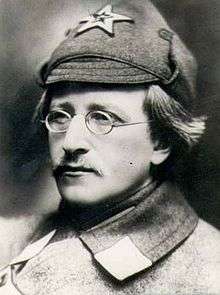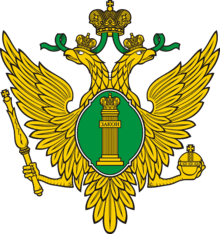Vladimir Antonov-Ovseyenko
Vladimir Alexandrovich Antonov-Ovseyenko (Russian: Владимир Александрович Антонов-Овсеенко; Ukrainian: Володимир Антонов-Овсєєнко; 9 March 1883 – 10 February 1938), real surname Ovseyenko, party aliases the 'Bayonet' (Штык) and 'Nikita' (Ники́та), a literary pseudonym A. Gal (А. Га́льский), was a prominent Ukrainian Bolshevik leader and diplomat.
Vladimir Antonov-Ovseyenko Владимир Антонов-Овсеенко | |
|---|---|
 | |
| People's Commissar of Military Affairs of the Russian SFSR | |
| In office 8 November 1917 – November 1917 | |
| Preceded by | Aleksandr Verkhovsky (Russian Provisional Government) |
| Succeeded by | Nikolay Podvoisky |
| People's Secretary of Military Affairs | |
| In office 7 March 1918 – 18 April 1918 | |
| Preceded by | Yuriy Kotsiubynsky |
| Succeeded by | Post dissolved Fyodor Sergeyev (All-Ukrainian Central MilRevKom) |
| Procurator General of the Russian SFSR | |
| In office 25 May 1934 – 25 September 1936 | |
| Premier | Vyacheslav Molotov |
| Preceded by | Andrey Vyshinsky |
| Succeeded by | Nikolai Ryckov |
| People's Commissariat for Justice of the Russian SFSR | |
| In office 1937–1938 | |
| Personal details | |
| Born | Vladimir Alexandrovich Ovseyenko 9 March 1883 Chernihiv, Chernigov Governorate, Russian Empire |
| Died | 10 February 1938 (aged 54) Butyrka Prison, Moscow, Russian SFSR, Soviet Union |
| Citizenship | Russia, Soviet |
| Political party | Menshevik (1903), Menshevik-Internationalist (1914), RSDLP(b) (1917) |
| Alma mater | Vladimir Military Institute, Nikolaevsk Combat Engineer Institute |
Early career
He was born in Chernigov the son of an infantry officer. He was of Ukrainian ethnicity.[1]
He studied at the secondary military school of Voronej, but left the army in 1901, and joined a student Marxist circle in Warsaw. He graduated from military college in St Petersburg in 1904.[2] In 1902 he secretly joined the Russian Social Democratic Labour Party (RSDLP), and set about organising a military section of the party among graduate officers in five cities. Early in the Russian Revolution of 1905, he led an uprising in Novo-Alexandria in Poland and was arrested for the first time, but escaped to Vienna in spring 1905. There he joined the Menshevik faction of the RSDLP. He returned to St Petersburg in May, and was made chairman of the military organisation of the RSDLP St Petersburg committee. Rearrested in April 1906, he broke jail five days later, and moved to Sevastopol, on Crimea, where he organised a military revolt. Arrested and sentenced to death, his sentence was later commuted to 20 years hard labour in Siberia. He escaped in June 1907, and hid out in Moscow, in the home of a sympathetic lawyer, Pavel Malyantovich. For three years, he worked among co-operatives and with the printers' union in Moscow, until his next arrest, after which he emigrated to Prussia, in July 1910, but was deported, and settled in Paris, where he acted as secretary of the Menshevik bureau.
Soon after the outbreak of World War I, Antonov-Ovseyenko broke with the Mensheviks, and founded the anti-war paper Golos (Голос - 'Voice'), later renamed Nashe Slovo (Наше слово - Our Word), which he co-edited with Leon Trotsky and Yuli Martov. He returned to Russia in June 1917, joined the Bolsheviks and was briefly head of the party organisation in Helsingfors, and Chairman of the Northern Congress of Soviets. He was arrested after the pro-Bolshevik riots in July, and detained, with Trotsky, in Krestny prison. He was freed on the day that the right wing military revolt led by General Kornilov collapsed, and returned to Helsingfors.
Storming the Winter Palace
Antonov-Ovseyenko returned to Petrograd in October 1917, and was appointed secretary of the Military revolutionary Committee of the Petrograd Soviet. This meant that he played a pivotal role in military preparations for the October Revolution. Trotsky, who witnessed him in action, described him as "politically shaky, but personally courageous - impulsive and disorderly, but capable of initiative..."[3] He personally led the famous storming of the Winter Palace, on 7 November (25 October according to Julian Calendar still used in Russia at the time), when Red Guards broke into the building where ministers of the Russian Provisional Government (excluding Prime Minister Alexander Kerensky), had taken refuge, and arrested them. They included Kerensky's Minister for Justice, Pavel Malyantovich, who had given Antonov-Ovseyenko sanctuary ten years earlier.[4] There were no lives lost in this incident, which took on something like mythical status in Soviet history. It formed the climax of the classic 1928 silent movie, October, directed by Sergei Eisenstein, in which Antonov-Ovseyenko took a starring role, playing himself.
Political career
In the initial government formed by Vladimir Lenin after the Bolsheviks had seized power, Antonov-Ovseyenko was appointed to the Military Committee of Sovnarkom. He was sent to lead the Bolsheviks side in the first, relatively bloodless engagement of the civil war, at Gatchina, against Kerensky and a detachment of Cossacks, but had to replaced after he virtually collapsed from nervous exhaustion.[5] On 21 December 1917, Antonov-Ovseyenko was put in charge of the Revolutionary forces in Ukraine and southern Russia. The army subsequently captured Kharkiv, where Soviet power in Ukraine was proclaimed. He opposed Lenin's decision to end the war with Germany, at the Treaty of Brest-Litovsk, and was dismissed from the Red Army in May 1918 for fermenting guerilla warfare against the advancing German army. He was reinstated as People's Commissar for War in Ukraine in September 1918, and oversaw the defeat of Ukrainian People's Republic and White Army forces in Ukraine, ensuring the creation of the Ukrainian SSR.
By the end of the Russian Civil War, Antonov-Ovseyenko was in charge of the Tambov Governorate, brutally suppressing 1920–21 Tambov Rebellion alongside Mikhail Tukhachevsky, with the use of chemical weapons.[6] In 1921, he was in charge of famine relief in the Samara region.
In 1922, Antonov-Ovseyenko was given the highly sensitive post of head of the Political Directorate of the Red Army, despite his public opposition to Lenin's New Economic Policy, which he denounced in a speech to the April 1922 Congress of the Communist Party of the Soviet Union (CPSU) as a sell-out to the peasants. During Lenin's terminal illness, he backed Trotsky in the struggle for succession. He was a signatory of The Declaration of 46 in October 1923, which called for greater party democracy. In December, after one of his subordinates had been sacked for criticising the leadership, he wrote an angry letter to the Central Committee exclaiming that "we are not courtiers to the throne of party hierarchs!"[7] In January 1924, he was summoned before the Orgburo, which was controlled by Josif Stalin, and sacked.
Later in 1923, Antonov-Ovseyenko was sent on a mission to China - the start of an 11-year career as a diplomat. In 1925, he was recalled and appointed Soviet representative in Czechoslovakia. He was one of a large group of Trotsky's supporters expelled from the CPSU in December 1927, but was one of the first to recant and seek readmission to the party during 1928. Later he was envoy in Poland, but in May 1934 was recalled to Moscow to serve as a Public Prosecutor. In this capacity, he observed the first of the great Moscow show trials, in which Grigory Zinoviev and Lev Kamenev were the main defendants, and signed an article in Izvestia calling for them to be shot. He was then posted to Barcelona, as Soviet Consul General, during the Spanish Civil War, where he directed the supply of Soviet aid to the Second Spanish Republic and where he organized the repression against the POUM party. He was recalled to Moscow in August 1937 where he talked with Joseph Stalin about the events in Spain. After a month without a job he was appointed People's Commissar for Justice of the Russian SFSR in September 1937, but after just one month in post, he was arrested during the night of 11–12 October 1937, and interrogated.[8] He was shot on 10 February 1938.
Antonov-Ovseyenko was the first former Trotskyist to be posthumously rehabilitated, and in 1956 was named in a speech by Anastas Mikoyan to the 20th party congress. Later, his son Anton, a historian, feared that he was to be 'un-rehabilitated', and fought a long rearguard battle to protect his reputation.
See also
- Albert Rhys Williams, American journalist that wrote numerous books about the revolutionary activities in Petrograd of 1917–18 as being the primary eyewitness of the events. He mentioned Ovseyenko as the military leader of the October Revolution. On several occasions he visited the Soviet Union before World War II.
- Anton Antonov-Ovseyenko (1920–2013), historian and writer, his son[9]
References
- "Жертвы политического террора в СССР". Lists.memo.ru. Retrieved 2013-06-12.
- Shmidt, O.Yu; Bukharin, N.I.; et al., eds. (1926). Большая советская энциклопедия volume 3. Moscow. p. 96.
- Trotsky, Leon (1967). History of the Russian Revolution, volume two. London: Sphere. p. 24.
- Antonov-Ovseyenko, Anton (1981). The Time of Stalin, Portrait of a Tyranny. New York: Harper & Row. p. 119. ISBN 978-0-06-039027-3.
- Abramovich, Ra[phael (1962). The Soviet Revolution. New York: International Universities Press. pp. 96–97.
- Nicolas Werth, Karel Bartošek, Jean-Louis Panné, Jean-Louis Margolin, Andrzej Paczkowski, Stéphane Courtois, The Black Book of Communism: Crimes, Terror, Repression, Harvard University Press, 1999, hardcover, 858 pages, ISBN 0-674-07608-7
- Antonov-Ovseyenko, Anton. The Time of Stalin. pp. 33–36.
- Medvedev, Roy (1976). Let History Judge, The origin and Consequences of Stalinism. Spokesman. p. 188.
- Директор Государственного музея ГУЛАГа Антон Владимирович Антонов-Овсеенко [Director of the State Museum of the Gulag, Anton Vladimirovich Antonov-Ovseenko]. svoboda.org (in Russian).
External links
| Wikimedia Commons has media related to Vladimir Alexandrovich Antonov-Ovseyenko. |
- Historical biography dictionary at hrono.ru (in Russian)
- Antonov-Ovseyenko at the protivpytok.org
